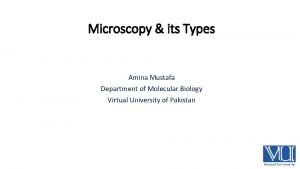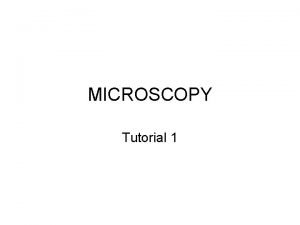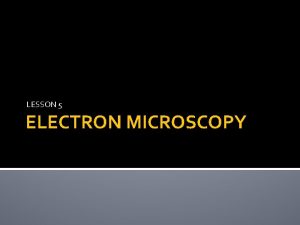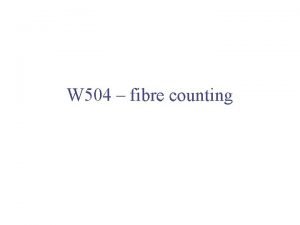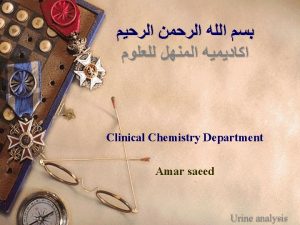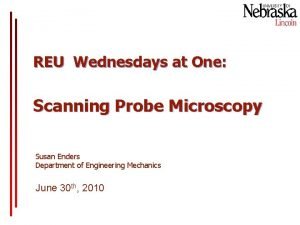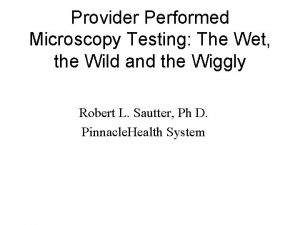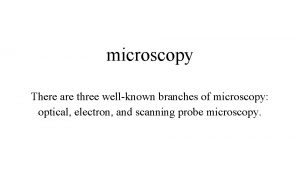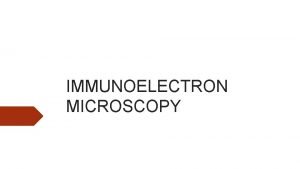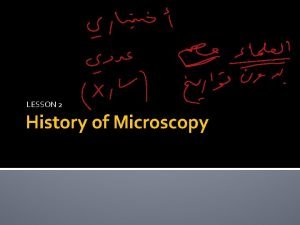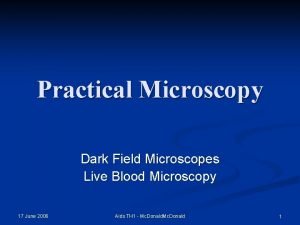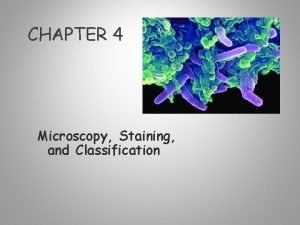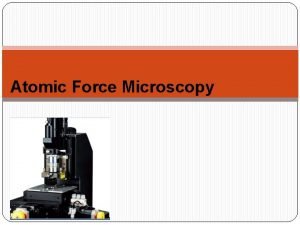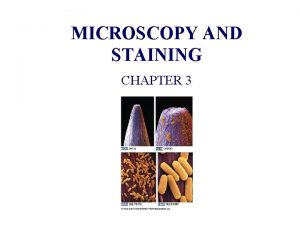Microscopy its Types Amina Mustafa Department of Molecular















- Slides: 15

Microscopy & its Types Amina Mustafa Department of Molecular Biology Virtual University of Pakistan

Microscopy Invented by : Antonie van Leeuwenhoek (Father of Microbiology)

Microscopy USES: • Diagnostics • Identification • Histology – Tissue analysis • Examining Forensic Evidence • Studying cells • Studying Micro-organisms • Scientific Research

Types of Microscopy • Simple Microscope • Compound Microscope • Dark Field Microscope • Phase Contrast Microscope • Flourescent Microscope • Interference Microscope • Electron Microscope • Atomic Force Microscope • Polarization Microscope

Simple Microscope USES: Study of microscopic algae, fungi and biological specimen

Compound/Bright-Field (Light) Microscopy

S. N. Simple Microscope Compound Microscope 1 Single lens 3 to 5 objective lenses 2 Has only one lens for magnifying objects. Has two sets of lenses for magnifying objects: eyepiece lens and objective lenses 3 Low Magnification Higher magnification. 4 Condenser lens is absent Condenser lens is present which is used to adjust the intensity of light for magnification of object. 5 Light source is natural Illuminator is a source of light 6 Has only one adjustment screw that is used to move the limb Has coarse adjustment screw (for rapid focusing an object) and up and down for focusing an object. fine adjustment screw (for fine and sharp focusing). 7 Can only be used in simple ways such as enlarging small letters while reading. Has a wide range of use such as in studying the structure of different objects

Dark-Field Microscope • Examination of unstained microbes • Special kind of condenser, with a dark-field stop, which is an opaque disc obstructing the path of light from the light source centrally, but allowing a peripheral ring of light

Phase Contrast Microscope Applications: • Cell culture • Live cell imaging Living cells can be observed in their natural state without previous fixation or labeling. Principle: When light passes through cells, small phase shifts occur. These phase shifts are converted into changes in amplitude, which can be observed as differences in image contrast.

Flourescent Microscope Principle. • The specimen is illuminated with light of a specific wavelength which is absorbed by the fluorophores, causing them to emit light of longer wavelengths • Florescent dyes are used for specimen staining • Examples of Flourescent stains: DAPI and Hoechst

Electron Microscope • Microscope with high magnification and resolution • Uses a beam of accelerated electrons as a source of illumination

Interference Microscope Principle: A prism is used to split light into two slightly diverging beams that then pass through the specimen. It is thus based on measuring the differences in refractive index upon recombining the two beams. Interference occurs when a light beam is retarded or advanced relative to the other

Atomic Force Microscope • High resolution • Measure in fractions of a nanometer • Uses a cantilever with a sharp probe that scans the surface of the specimen

Polarization Microscope • Used mainly in geological studies for geological specimens but also in medicine and biology. • Uses a polarized light, in which the light waves vibrate in one direction.

Organism Group Bright-Field Microscopy Fluorescence Microscopy Dark-Field Microscopy Electron Microscopy Bacteria + + ± – Fungi + + – – Parasites + + – ± Viruses – + – ±
 Etil metil propilamina
Etil metil propilamina Amina mustafa
Amina mustafa Types of microscopy
Types of microscopy Types of microscopy
Types of microscopy What is a covalent bond simple definition
What is a covalent bond simple definition Ionic covalent metallic
Ionic covalent metallic Giant molecular structure vs simple molecular structure
Giant molecular structure vs simple molecular structure Disadvantages of phase contrast microscopy
Disadvantages of phase contrast microscopy Selective medium for vibrio cholerae
Selective medium for vibrio cholerae Amorphous phosphate in urine
Amorphous phosphate in urine Advantages of scanning probe microscope
Advantages of scanning probe microscope Provider-performed microscopy procedures examples
Provider-performed microscopy procedures examples Oa module
Oa module Branches of microscopy
Branches of microscopy Pyuria leukocytes urine
Pyuria leukocytes urine What is forensic microscopy
What is forensic microscopy

